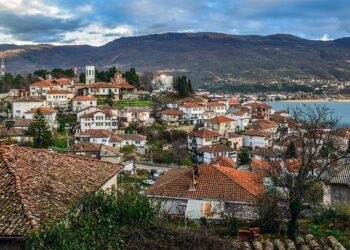North Macedonia’s prime minister has sparked controversy by attributing the country’s devastating summer wildfires to a shortage of cows and sheep. As the region grapples with widespread blazes that have scorched thousands of hectares, government officials and experts are weighing in on the unusual explanation. This statement highlights ongoing debates over land management, climate change, and rural policies amid increasingly severe fire seasons across the Balkans.
Macedonian Prime Minister Attributes Summer Wildfires to Reduced Livestock Population
The Macedonian Prime Minister recently pointed to a significant decline in livestock numbers, specifically cows and sheep, as a contributing factor to the severe wildfires that ravaged the country this summer. According to officials, these animals traditionally help manage vegetation through grazing, which reduces the amount of dry plant material available to fuel fires. With fewer livestock on the fields, this natural firebreak has weakened, creating conditions ripe for wildfires to spread rapidly.
Key factors highlighted include:
- Decreased grazing pressure on grasslands and shrubbery
- Accumulation of dry biomass increasing fire hazards
- Reduced natural maintenance of rural landscapes
| Year | Livestock Population (Thousands) | Wildfire Incidents |
|---|---|---|
| 2018 | 350 | 25 |
| 2022 | 220 | 43 |
| 2024 | 180 | 54 |
Environmental experts have weighed in, noting that while livestock reduction is a factor, broader climate change effects and forest management practices are also critical in understanding the wildfire crisis. The government is now exploring comprehensive solutions that combine wildlife management with modern fire prevention techniques to better safeguard the region in future seasons.
Environmental Experts Challenge Claims Linking Livestock Decline to Wildfire Spread
Environmental specialists have strongly disputed recent assertions made by Macedonia’s prime minister attributing the intensity and rapid spread of this summer’s wildfires to a decline in livestock populations, specifically cows and sheep. Experts argue that fire behavior is influenced by a complex interplay of factors, including prolonged drought, rising temperatures, and land management practices rather than solely by grazing trends. According to Dr. Elena Petrova, a wildfire ecologist, “Reducing the causes of wildfires to livestock numbers oversimplifies the core problem and diverts attention from critical climate-driven changes and inadequate forestry policies.”
Research shows that grazing can impact vegetation density, but it is not a decisive factor in controlling wildfire spread. In fact, some environmentalists warn against promoting livestock grazing as a wildfire prevention strategy without comprehensive ecological analysis. Listed below are some key components influencing wildfires:
- Climatic Conditions: High temperatures and prolonged dryness exacerbate fire risks.
- Vegetation Type and Density: Accumulated dry biomass serves as fuel.
- Human Activity: Land use and fire suppression policies significantly affect wildfire dynamics.
- Topography: Wind patterns and terrain shape fire movement.
| Factor | Impact on Wildfires |
|---|---|
| Livestock Grazing | Moderate; reduces some vegetation but limited effect overall |
| Climate Change | High; increases drought frequency and severity |
| Vegetation Management | High; critical for fuel load control |
| Fire Prevention Policies | High; determines response and preparedness |
Strategies for Enhancing Fire Prevention Amid Changing Agricultural and Environmental Conditions
Adaptation to shifting agricultural patterns and evolving environmental conditions is crucial for effective fire prevention. One approach involves integrating controlled grazing practices to reduce excess dry vegetation that fuels wildfires. This method not only manages land sustainably but also supports local livestock economies when balanced correctly. Additionally, investing in early detection technologies, such as satellite monitoring and AI-driven fire risk models, can help anticipate high-risk periods, allowing authorities to deploy resources proactively.
Building community resilience through education and collaboration is equally important. Engaging farmers, herders, and local residents in fire-smart land management encourages shared responsibility and rapid response. Below is a concise comparison of some strategic measures highlighting their benefits:
| Strategy | Primary Benefit | Implementation Challenge |
|---|---|---|
| Controlled Grazing | Reduces flammable biomass | Requires herd management |
| Early Detection Tech | Enables rapid response | High initial costs |
| Community Engagement | Improves local readiness | Needs ongoing training |
Closing Remarks
As investigations continue into the causes and impacts of this summer’s wildfires in North Macedonia, the Prime Minister’s remarks linking livestock shortages to the devastation have sparked widespread debate. Experts and local communities alike call for a deeper examination of environmental policies and climate factors driving the region’s increasing vulnerability to fires. With the wildfire season showing no signs of abating, the government faces growing pressure to implement effective prevention and response strategies to safeguard both its natural landscapes and citizens.















